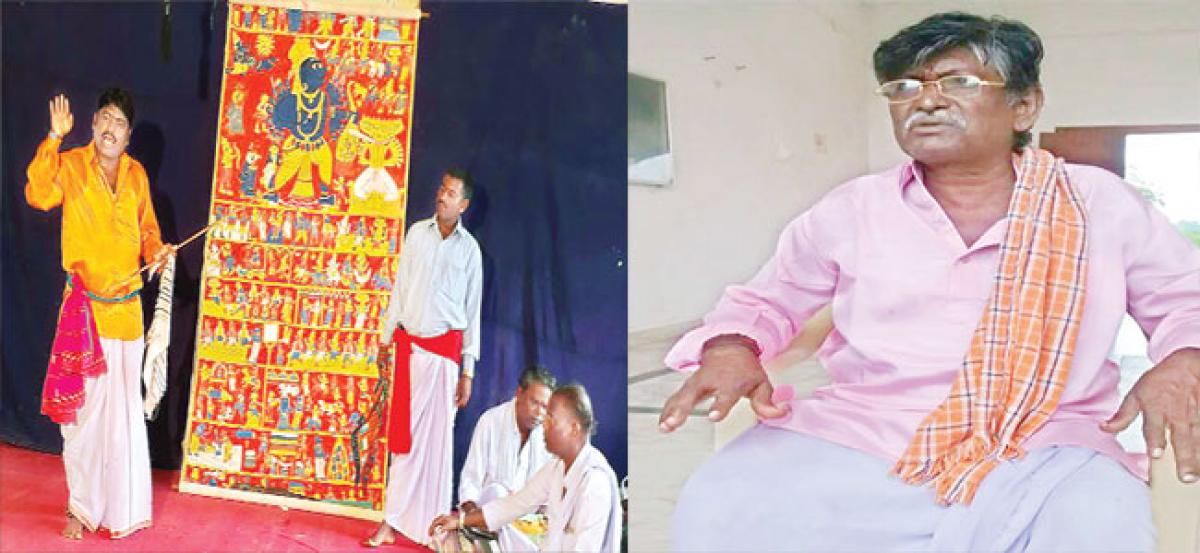Live
- A Guide to Temperature and Humidity Standards in Data Center Server Rooms
- Gadwal collector briefs on details of voters
- Jupally Krishna Rao takes part in Alampur rallu
- Bharath Prasad files 3rd Nomination
- Baisakh Month: A Time of Auspicious Beginnings and Sacred Festivals
- Oust BJD govt for overall development, says Shah
- Unveiling the Hidden Gems: Surprising Health Benefits of Garlic Peels
- Overcoming Sleep Struggles: A Comprehensive Guide to a Restful Night
- RTC bus hit the auto
- MLA Kuchukula Rajesh Reddy participated in the Birappa festival
Just In

“Ours is the last generation to recite Madelaiah Puranam, there will be none to tell the story to the future generations,” worried 65-year-old Bonagiri Sammaiah of Bollikunta village near Warangal city. He has been engaged in the rendition of verbal lore since he was 18 years of age but stopped now due to his advanced age.
Warangal: Like many folklores, once an eternal part of every culture since ages and now on the verge of extinction, one of the verbal lore of Telangana ‘Madelaiah Puranam’ or ‘Rajaka Puranam’ is also set to become extinct.
Though there is a considerable patronage to the art form, which has a religious character, the number of story tellers has diminished acutely over the years. There are only six story tellers now available in Telangana with two in Warangal.
“Ours is the last generation to recite Madelaiah Puranam, there will be none to tell the story to the future generations,” worried 65-year-old Bonagiri Sammaiah of Bollikunta village near Warangal city. He has been engaged in the rendition of verbal lore since he was 18 years of age but stopped now due to his advanced age.
Those, who narrate Madelaiah Puranam, are called Patamvaru or Masaiahlu and they use a ‘Patam’, a scroll painting with graphical depiction of the story they tell. They are dependent community of Rajakas (Washermen) and Madelaiah is said to be an incarnation of Lord Virabhadra.
Madelaiah Puranam, is transmitted by word of mouth to the next generation. Young men are now switching over to regular professions due the factors such as indignity of dependence, uncertain income and the lure of getting gainful employment,
Sammaiah explained.
There is now only one troupe each in Nalgonda and Karimnagar besides Warangal. “20 years ago there used to be around 60 troupes in Telangana and they used to visit their Kattadi (Right of getting livelihood) villages and get paid by Rajakas after three days of storytelling,” he pointed out.
The legend has it that, Lord Virabhadra, who was sent to destroy Daksha Yajna by Lord Siva, was supposed to have committed a grave sin by the destruction of Yajna. Siva ordered him to wash the clothes of gods to propitiate his sin.
Virabhadra goes to a lake worrying over ignominy of such act. Two drops of his sweat fell on two lotus flowers in the lake. One such drop emerged as Madeivelu Machaiah, who was ordered to wash the clothes of gods.
After completing the job, he approached Virabhadra and prayed him to show him the source for his livelihood. Virabhadra asked him to go to Bhuloka and wash the clothes of men and thus earn his livelihood. His progeny came to be known as Rajakas.
Another person, who emerged out of the drop of sweat of Virabhdra, refused to wash the clothes. He was cursed by Virabhadra to depend on Rajakas for the livelihood. Thus a dependant caste of Masaiahs came into being. Documenting
the art form With an objective to preserve the art form, Telugu University’s Janapada Girijana Vignana Peetham is now documenting Madelaiah Puranam by engaging Sammaiah, his brother B Sangaiah, son Srinivas and the team.
“With the active encouragement from the Director of Language and Culture, Mamidi Harikrishna, we have embarked on this project and engaged in audio visual documentation,” informed the Peetham Dean Prof B Ramesh.
It takes three days to narrate Madelaiah Puranam completely. It consists of Shakti Puranam, Parvati Kalyanam, Daksha Yagnam, Virabhadra Vijayamu, Basava Puranam and Madelaiah Charitra (history), explained Gaddam Venkanna, who is an assistant professor and Head of Folklore Studies at the Peetham.
By James Edwin

© 2024 Hyderabad Media House Limited/The Hans India. All rights reserved. Powered by hocalwire.com







